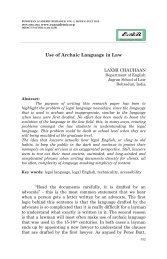Pedro Ordóñez Eslava - European Academic Research
Pedro Ordóñez Eslava - European Academic Research
Pedro Ordóñez Eslava - European Academic Research
You also want an ePaper? Increase the reach of your titles
YUMPU automatically turns print PDFs into web optimized ePapers that Google loves.
<strong>Pedro</strong> <strong>Ordóñez</strong> <strong>Eslava</strong> - Poetry and music, between José Angel Valente and Mauricio<br />
Sotelo<br />
in a relative way, for instance, to the internal poetic resonance<br />
in Valente‟s thought.<br />
On the other hand, silence is also crucial in the formal<br />
structure of Nono‟s quartet: the radical absence of sound is<br />
understood as an apollonian space of self-thinking for the<br />
listener and it should be assumed to be „spazi sognanti‟, „stasi<br />
improvivise‟, „pensieri indicibili‟, „respiri tranquilli‟ by<br />
performer: without any kind of sound, just the performing<br />
gesture gets here a decisive poetic and conceptual purpose.<br />
The poetic conception in Valente‟s Lessons, on the one<br />
hand, and the æsthetic approach in Nono‟s latest works, among<br />
others, are the columns of Sotelo‟s thought even since the midnineties,<br />
when he writes Memoriæ. Escritura interna sobre un<br />
espacio poético de José Ángel Valente, for cello and double bass,<br />
commissioned by the Spanish Center for Contemporary Music<br />
of Contemporary Music and premiered during the International<br />
Contemporary Music Festival of Alicante in September 1994.<br />
We could distinguish three different sections in this<br />
piece, with a ceaseless play between the stillness of hanged<br />
chords and the vigorous drive of glissandi, exceptionally fast<br />
glissandi, if we bear in mind the kind of instruments for which<br />
it is written. Likewise, Memoriæ stays always on the edge of<br />
sound itself through a continuous work with overtones,<br />
something that takes the piece far from the conventional<br />
hearing: we can see here a sort of a journey to the musical root<br />
of every tone to show us its physical constitution; a travel to the<br />
heart of the note in searching of quietness and, maybe, of a<br />
certain kind of musical ideality „hidden behind sounds or even<br />
between them‟, as Merleau-Ponty asserts.<br />
Hence, the most interesting moment in this piece is the<br />
measure 26, when the discourse of cello and double bass is<br />
suddenly cut by a deep silence, but with „arc fermo sulle corde‟;<br />
both players must hold in „assoluto silenzo‟ -„absolute silence‟.<br />
Here, the musical gesture acquires even greater significance in<br />
the absence of sound, in a sort of no-sound in which hearing<br />
stops to see itself in the inner field of listener, to go to the „seed<br />
of listening‟, as Valente himself asserts in his Lessons alluded<br />
before.<br />
Sotelo draws up in Memoriæ a sort of „hidden quote‟, an<br />
intertextual reference taken to a wider conceptual mean, not<br />
EUROPEAN ACADEMIC RESEARCH, VOL. I, ISSUE 1/ APRIL 2013<br />
20



